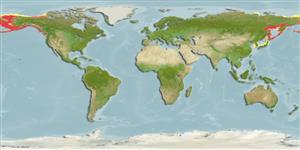>
Gadiformes (Cods) >
Gadidae (Cods and haddocks)
Etymology: Eleginus: Greek, eleginos, -ou = a fish of the Nile (Ref. 45335).
Environment: milieu / climate zone / depth range / distribution range
Sinh thái học
Biển; Nước ngọt; Thuộc về nước lợ gần đáy; sống cả ở nước ngọt và nuớc mặn; Mức độ sâu 0 - 300 m (Ref. 50550). Polar; 75°N - 30°N, 124°E - 123°W (Ref. 54430)
Arctic to North Pacific: Chemulpo in North Korea (Yellow Sea) in the southwest to Sitka, Alaska in the southeast. Beyond the Bering Strait from Cape Lisburne in Chukchi Sea and east to Dease Strait (south coast of Victoria Island). Precise delimitation of the range depends on additional taxonomic study.
Length at first maturity / Bộ gần gũi / Khối lượng (Trọng lượng) / Age
Maturity: Lm 30.0 range ? - ? cm
Max length : 55.0 cm TL con đực/không giới tính; (Ref. 1371); Khối lượng cực đại được công bố: 1.3 kg (Ref. 56527); Tuổi cực đại được báo cáo: 15 các năm (Ref. 56527)
Các tia vây lưng cứng (tổng cộng) : 0; Các vây lưng mềm (tổng cộng) : 44 - 59; Tia cứng vây hậu môn: 0; Tia mềm vây hậu môn: 39 - 47; Động vật có xương sống: 57 - 64. Distinguished by the presence of 3 dorsal and 2 anal fins, a lower jaw that is shorter than the upper, a chin barbel that is no longer than half the eye diameter, and a space between the second and third dorsal fins that is equal to or longer than the eye diameter (Ref. 27547). Lateral line curved in front, ending under the second dorsal fin (Ref. 27547); head with no lateral line pores (Ref. 1371). Expanded parapophyses swollen and hollow, beginning on about the vertebral centrum 9 or 10, containing outpouchings of the swim bladder (Ref. 1371). Second pelvic ray produced; caudal truncate or slightly emarginate (Ref. 27547). Grayish brown above, upper part of sides paler, sometimes with a silvery-violet shading, often mottled with indistinct darker blotches; lower sides and belly yellowish to silver white; fins dusky, dorsal and caudal with white edges (Ref. 27547).
Occurs in shallow coastal waters (Ref. 1371). Enters rivers and may go considerable distances upstream, but usually remaining within regions of tidal influence (Ref. 1371, 27547). Adults exhibit seasonal movements: inshore during winter for purposes of spawning and offshore during summer for feeding (Ref. 1371). Juveniles and adults are opportunistic epibenthic feeders; juveniles feed on fish and small benthic crustaceans (Ref. 1371). Taxonomic problems to be solved.
Spawns 5-7 times in its life, or even 9-10 times for those living 10-14 years. Fecundity varies with geographical region. It decreases from east to west in the European Arctic and from south to north in western Pacific waters. Throughout its distribution area, spawning occurs during January-February in coastal zones of bays and inlets on sand-gravel substrate and in strong tidal currents.
Cohen, D.M., T. Inada, T. Iwamoto and N. Scialabba, 1990. FAO species catalogue. Vol. 10. Gadiform fishes of the world (Order Gadiformes). An annotated and illustrated catalogue of cods, hakes, grenadiers and other gadiform fishes known to date. FAO Fish. Synop. 125(10). Rome: FAO. 442 p. (Ref. 1371)
IUCN Red List Status (Ref. 130435)
Threat to humans
Harmless
Human uses
Các nghề cá: tính thương mại cao
Các công cụ
Special reports
Download XML
Các nguồn internet
Estimates based on models
Preferred temperature (Ref.
123201): -1.5 - 5.9, mean 0.9 °C (based on 952 cells).
Phylogenetic diversity index (Ref.
82804): PD
50 = 0.7500 [Uniqueness, from 0.5 = low to 2.0 = high].
Bayesian length-weight: a=0.00617 (0.00539 - 0.00705), b=3.08 (3.04 - 3.12), in cm total length, based on LWR estimates for this species (Ref.
93245).
Mức dinh dưỡng (Ref.
69278): 4.1 ±0.6 se; based on diet studies.
Generation time: 5.5 (4.4 - 6.9) years. Estimated as median ln(3)/K based on 25
growth studies.
Thích nghi nhanh (Ref.
120179): Trung bình, thời gian nhân đôi của chủng quần tối thiểu là 1.4 - 4.4 năm (tm=2-3; Fec=4,900).
Prior r = 0.57, 95% CL = 0.37 - 0.85, Based on 1 data-limited stock assessment.
Fishing Vulnerability (Ref.
59153): Moderate to high vulnerability (47 of 100).
Climate Vulnerability (Ref.
125649): Moderate to high vulnerability (47 of 100).
Nutrients (Ref.
124155): Calcium = 22.8 [12.2, 62.4] mg/100g; Iron = 0.45 [0.22, 0.95] mg/100g; Protein = 17.5 [16.0, 19.0] %; Omega3 = 0.377 [0.185, 0.804] g/100g; Selenium = 13.8 [5.4, 30.4] μg/100g; VitaminA = 15.6 [2.9, 81.7] μg/100g; Zinc = 0.411 [0.263, 0.636] mg/100g (wet weight);
